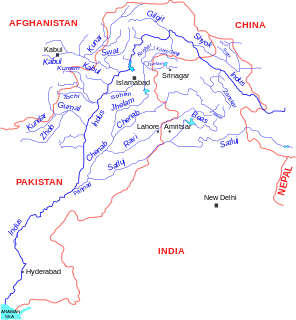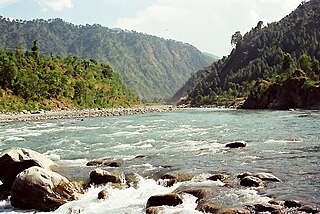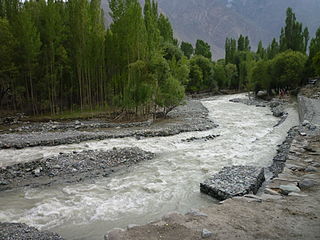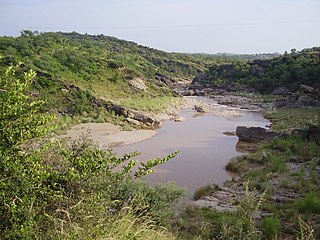 W
WAstor River, in Pakistan's Gilgit-Baltistan administrative region, is a tributary of the Indus River and one of the rivers draining the Deosai Plateau, running through Astore Valley. The river originates from western slopes of Burzil Pass.
 W
WThe Beas River is a river in north India. The river rises in the Himalayas in central Himachal Pradesh, India, and flows for some 470 kilometres (290 mi) to the Sutlej River in the Indian state of Punjab. Its total length is 470 kilometres (290 mi) and its drainage basin is 20,303 square kilometres (7,839 sq mi) large.
 W
WThe Chip Chap River is a tributary of the Shyok River that flows from the disputed Aksai Chin region administered by China to Ladakh in India. It originates at the eastern edge of the Depsang Plains and flows west, skirting around the Depsang Plains in the north. It discharges into the Shyok River, forming one of the upstream tributaries of the Indus River.
 W
WThe Galwan River flows from the disputed Aksai Chin region administered by China to the Ladakh union territory of India. It originates to the east of the area of Samzungling on the eastern side of the Karakoram range and flows northwest to join the Shyok River. The point of confluence is 102 km south of Daulat Beg Oldi on the Darbuk–Shyok–DBO Road. Shyok River itself is a tributary of the Indus River making Galwan a part of the Indus River system.
 W
WThe Gilgit River is a tributary of the Indus River, and flows past the town of Gilgit and Golaghmuli Valley. It is located in the Gilgit–Baltistan province of Pakistan. The Gilgit River starts from Shandur Lake, joins the Indus River at junction point of three mountains ranges near town of Juglot.
 W
WGomal River is a 400-kilometre-long (250 mi) river in Afghanistan and Pakistan.
 W
WHunza River(Urdu: دریائے ہنزہ) is the principal river of Hunza in Gilgit–Baltistan, Pakistan It is formed by the confluence of the Chapursan and Khunjerab nalas (gorges) which are fed by glaciers. It is joined by the Gilgit River and the Naltar River, before it flows into the Indus River.
 W
WThe Jhelum River is a river in northern India and eastern Pakistan. It is the westernmost of the five rivers of the Punjab region, and passes through the Kashmir Valley. It is a tributary of the Chenab River and has a total length of about 725 kilometres (450 mi).
 W
WThe Kabul River, the classical Cophen, is a 700-kilometre-long (430 mi) river that emerges in Maidan Wardak Province in the Sanglakh Range of the Hindu Kush mountains in Afghanistan, and is separated from the watershed of the Helmand River by the Unai Pass. The Kabul River empties into the Indus River near Attock, Pakistan. It is the main river in eastern Afghanistan and the Khyber Pakhtunkhwa province of Pakistan.
 W
WThe Nubra River is a river in the Nubra Valley of Ladakh in India. It is a tributary of the Shyok River and originates from the Siachen Glacier, the second-longest non-polar glacier in the world. In earlier Tibetan maps, it was referred as Yarma Tsangpo.
 W
WPanjnad River (Urdu/Punjabi Shahmukhi: پنجند, is a river at the extreme end of Bahawalpur district in Punjab, Pakistan. Panjnad River is formed by successive confluence or merger of the five rivers of the Punjab, namely Jhelum, Chenab, Ravi, Beas and Sutlej. Jhelum and Ravi join Chenab, Beas joins Sutlej, and then Sutlej and Chenab join to form Panjnad 10 miles north of Uch Sharif in Muzaffar Garh district. The combined stream runs southwest for approximately 45 miles and joins the Indus River at Mithankot. The Indus continues and then drains into the Arabian Sea. A barrage on Panjnad has been erected; it provides irrigation channels for Punjab and Sindh provinces south of the Sutlej and east of the Indus rivers.
 W
WThe Ravi River is a transboundary river crossing northwestern India and eastern Pakistan. It is one of six rivers of the Indus System in Punjab region.
 W
WSaltoro River is a tributary river of Shyok River in the Siachen Region. Its main source is Bilafond Glacier. Before falling into Shyok river, the water of Saltoro river first drains into Hushe river at Haldi village which finally falls in Shyok.
 W
WShigar River is located in the mountainous Baltistan region of northern Pakistan. The Shigar River is formed from the melted water of the Baltoro Glacier and Biafo Glacier. It flows through the Shigar Valley. The river is tributary to Indus River and meets the Indus in Skardu Valley.
 W
WThe Shyok River a tributary of the Indus River that flows through northern Ladakh and enters Gilgit–Baltistan, spanning some 550 km (340 mi).
 W
WThe Soan River, also referred to as the Swan, Sawan, or Sohan, is a river in Punjab, Pakistan.
 W
WThe Sutlej River is the longest of the five rivers that flow through the historic crossroads region of Punjab in northern India and Pakistan. The Sutlej River is also known as Satadree. It is the easternmost tributary of the Indus River.The bhakra dam is built around the river Sutlej to provide irrigation and other facilities to the nearby areas.
 W
WThe Uhl is a Himalayan river which is part of the watershed of Beas river. The river originates at the Thamsar Glacier in the Dhauladhar range of the Himalayas, flows through the Uhl valley crossing the villages Bada Gran (Baragram) and Barot. In its lower course, it is also known as Tiun Nala and the Uhl valley is known as Chohar valley. After passing the Chohar valley, the Uhl meets the Beas river 5 km downstream from Pandoh.
 W
WThe Yapola, also known as the Wanla River, is a river in Ladakh, northern India. It flows into the Indus River near Lamayuru.
 W
WThe Zanskar River is a north-flowing tributary of the Indus. In its upper reaches, the Zanskar has two main branches. First of these, the Doda, has its source near the Pensi-la 4,400 m (14,400 ft) mountain-pass and flows south-eastwards along the main Zanskar valley leading towards Padum, the capital of Zanskar. The second branch is formed by two main tributaries known as Kargyag river, with its source near the Shingo La 5,091 m (16,703 ft), and Tsarap river, with its source near the Baralacha-La. These two rivers unite below the village of Purne to form the Lungnak river. The Lungnak river then flows north-westwards along a narrow gorge towards Zanskar's central valley, where it unites with the Doda river to form the main Zanskar river. This river then takes a north-eastern course through the dramatic Zanskar Gorge until it joins the Indus near "Nimmu" in Ladakh.